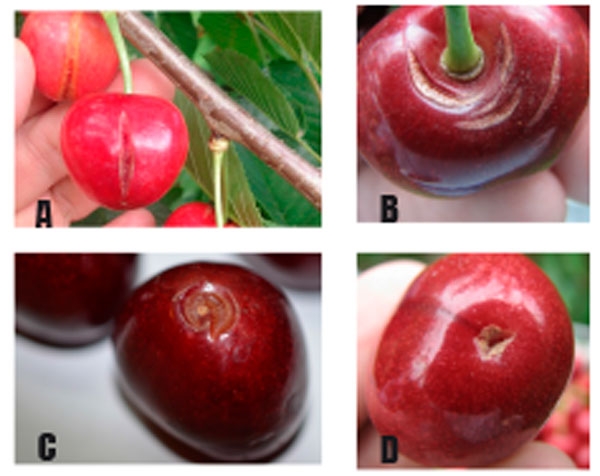Fruit splitting or 'cracking' results in significant economic loss to cherry producers around the world.
Fruit can split as a result of rapid and sudden water uptake by the roots; or from rain or dense fog on the fruit.
Trials
Research to minimise fruit cracking was conducted in Lapins and Sweetheart. Both varieties are popular in Chile and have medium or high susceptibility to cracking.
Treatments
There were four treatments plus a control. Two treatments used commercial products at recommended rates, and two used different concentrations of Crackguard.
There were three applications made while fruit were susceptible to cracking. The first at straw colour; then at 7 and 14 days after straw colour.
Types of fruit cracking
Transversal: characterised by cracks on the cheeks of fruit, regardless of length, width, depth and position (Fig. 1a). Often occur from rapid absorption of water by the roots and contact between fruit.
Half moon: cracks generated around the fruit stem, mainly due to water accumulation (Fig. 1b). Cracking is classified as ‘mild’ when less than one-quarter of the circumference around the fruit stem is cracked, or ‘severe’ when cracking is greater.
Apical: cracks generated in the apical region of the fruit in concentric circles around the pistil (Fig 1c). This type of damage may result from an accumulation of sugars.
Star: Severe cracking at the blossom end (Fig 1d). Often found in varieties that bear large fruit.
Cracking Index
To calculate the index of cracking the following formula is used:
IC = (5a + 3b + c) / 250) x 100
Where:
a = Number of fruit splits at 2 hours
b = Number of fruit splits at 4 hours
c = Number of fruit splits after 6 hours
Results of incidence and type of fruit splits in the field
Table 1 is an analysis of field splits as a percentage, for the different treatments in Lapins (2014–2015 season).
Table 2 is an analysis of splits as a percentage measured at four hours, for the different treatments in Lapins (2014–2015 season).
Results of Cracking Index I.C.
Table 3 is the Cracking Index (IC) for the treatments in Lapins 2014–2015 season.
Table 4 is the Cracking index (IC) for the treatments in Sweetheart 2014–2015 season.
Result
The results of this trial show that implementing a program using Crackguard is the most effective way of minimising the damage or incidence of cherry fruit cracking before a rainfall event.
See the complete article in Tree Fruit September 2015




















